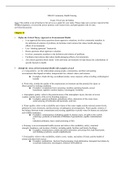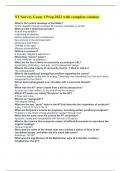1
NR442 Community Health Nursing
Exam 3 Overview & Outline
Note: This outline is not all inclusive but serves as a guide for your study. Please make sure you have read all of the
assigned chapter(s), reviewed the power point(s), your lecture notes, and participated in the in-class
activities/discussions.
Chapter 14
• Define the Critical Theory Approach to Environmental Health
o Is an approach that raises questions about oppressive situations, involves community members in
the definition & solution of problems, & facilitates interventions that reduce health-damaging
effects of environments
o Uses “thinking upstream” framework.
o Raises questions about oppressive situation.
o Involves community members in the definition and solution of problems.
o Facilitates interventions that reduce health-damaging effects of environments.
o Ask critical questions about clients’ work and home environments to help discern the contributions of
specific hazards to health.
• Identify the Areas of Environmental Health with examples of each
a. Living patterns: are the relationships among people, communities, and their surrounding
environments that depend on habits, interpersonal ties, cultural values, and customs.
▪ Examples: drunk driving, secondhand smoke, noise exposure, urban crowding, technological
hazards
b. Work risks: include the quality of the employment environment and the potential for injury or
illness posed by working conditions.
▪ Examples: occupational toxic poisoning, machine-operating hazards, sexual
harassment, repetitive motion injuries, carcinogenic worksites
c. Atmospheric quality: refers to the protectiveness of the atmospheric layers, the risks of severe
weather, and the purity of the air for breathing purposes
▪ Examples: gaseous pollutants, greenhouse effect, destruction of the ozone layer,
aerial spraying of herbicides and pesticides, acid rain
d. Water quality: refers to the availability and volume of the water supply and the mineral content levels,
pollution by toxic chemicals, and the presence of pathogenic microorganisms. Water quality consists of
the balance between water contaminants and existing capabilities to purify water for human use and plant
and wildlife sustenance.
▪ Examples: contamination of drinking supply by human waste, oil spills in the world's
waterways, pesticide or herbicide in filtration of groundwater, aquifer contamination
by
industrial pollutants, heavy metal poisoning of fish
e. Housing: is an environmental health concern and refers to the availability, safety, structural
strength, cleanliness, and location of shelter, including public facilities and family dwellings.
▪ Examples: homelessness, rodent and insect infestation, poisoning from lead-based paint,
sick building syndrome, unsafe neighborhoods
f. Food quality: refers to the availability, relative costs, variety, and safety of foods, and the health of
animal and plant food sources.
▪ Examples: malnutrition, bacterial food poisoning, food adulteration, disrupted food chains by
ecosystem destruction, carcinogenic chemical food additives
, 2
g. Waste control: is the management of waste materials resulting from industrial and municipal
processes, human consumption, and efforts to minimize waste production.
▪ Examples: use of nonbiodegradable plastics, poorly designed solid-waste dumps,
inadequate sewage systems, transport and storage of hazardous waste, illegal industrial
dumping
h. Radiation risks: are health dangers posed by the various forms of ionizing radiation relative to
barriers preventing exposure of humans and other life forms.
▪ Examples: nuclear facility emissions, radioactive hazardous wastes, radon gas seepage
in homes and schools, nuclear testing, excessive exposure to x-rays
i. Violence risks: violence include the potential for victimization through the violence of
particular individuals and the general level of aggression in psychosocial climates.
• Describe the Effects of Environmental hazards
o Effect on the public’s health is complex & generally interconnected (nuclear power plant emissions
may contaminate water & air supplies, affecting water quality, atmospheric quality, & radiation
risk)
o A direct relationship to the development of some cancers, chronic diseases, & other health-related
problems
o Effects of environmental risks may also be indirect (global warming)
o Effects of environmental hazards may be general or specific (extensive smog, drought,
high unemployment)
o Can be immediate (burns, gunshot wounds, hurricane damage, & outbreaks of GI distress), long term
(occupational hearing loss, black lung in coal miners, & increased rates of thyroid cancer among
young victims of the Chernobly accidents, or transgenerational -(female factory workers exposed to
radiation at plutonium-processing plants)
• Describe how to the Approach Environmental Health at the Aggregate Level
o Focuses on health promotion & disease prevention in specific areas
o Facilitate community participation in identifying & solving environmental health problems &
bring about changes that improve environments & eliminate hazards
• Critical Community Health Nursing Practice
o Take a Stand: Advocating for Change – must make individual & collective decisions about
which interests they want to serve w/ their specialized knowledge & skills
▪ Potential to make increase/decrease these inequities through the decisions they make about
the positions they accept & the interventions they undertake
o Asking Critical Questions – ask how policies concerning ecological preservation, energy, housing,
immigration, civil rights, crime, nutrition, minimum wage, occupational safety, & defense might
affect the well-being of people
▪ Addressing who has access to resources in this country, & whose interests are served in the
existing system, provides a way to include social, political, & economic factors in
environmental nursing assessments
▪ Can frame the problem & assist in building collective strategies
o Facilitating Community Involvement – to help people learn form their own experiences & analyze
the world w/an intention to change it
▪ Essential that the affected people participate in the process of identifying & working to solve
environmental problems
▪ Nurses must be prepare to take leadership positions & join in mutual exchanges w/
community members that consider each person’s experience
, 3
• Provide support, information, & expertise to groups to assist them in meeting
the goals they set for environmental change
• Help community members look beyond immediate environmental problems &
explore social, cultural, economic, & political circumstances that contribute to
them
o Forming Coalitions – to produce social change, join w/communities to eliminate hazards &
improve public health
▪ Nurse can expose hazards, assess needs, plan actions, report abuses, & secure appropriate
resources, personnel, funding, & legislative changes
• Helping community groups make connections w/larger, more powerful organizations
• Each issue or problems requires appropriate strategic action based on its own merits
o Using Collective Strategies – use a variety of strategies to intervene at the aggregate level &
facilitate improvement in a community’s health
▪ Participation action research – nurses, community members, & other resource people to work
together in identifying environmental health problems, designing the studies, collecting
& analyzing the data, disseminating the results, & posing solutions to the problems
• Distinguish between environmental health approaches that focus on altering individual behaviors &
those that aim to change health-damaging environments.
o Altering individual behaviors –address deleterious personal habits through exercise programs,
weight- loss regimens, smoking cessation classes, & stress-reduction tactics
o Change health-damaging environments – work w/the public to promote more stringent &
actively enforced environmental legislation & regulations
▪ Support actions for biodiversity (pushing back the deserts, replanting the forests, stabilizing
the climate, & seeking alternative development pathways that do not destroy plant &
animal species
▪ Incorporate that fact that individual & community health ultimately depends on
global environmental integrity
• Identify aggregates at risk for particular environmental health problems.
o Non-English-speaking individuals
o Children
o Very-low income women & families
o Undocumented manual laborers
o People from racial & ethnic minorities
Chapter 15
• Describe & define the Patterns of Health and Disease
o Lifestyles, health and cultural beliefs, infrastructure, economics, and politics affect existing
illnesses and society’s commitment to prevention.
o Disease patterns vary throughout the world.
o Racial, ethnic, and access disparities exist within and between countries.
• Describe globalization
o The process of increasing social and economic dependence and integration as capital, goods, persons,
concepts, images, ideas, and values cross state boundaries, is inextricably linked to the benefits and
challenges of our time





